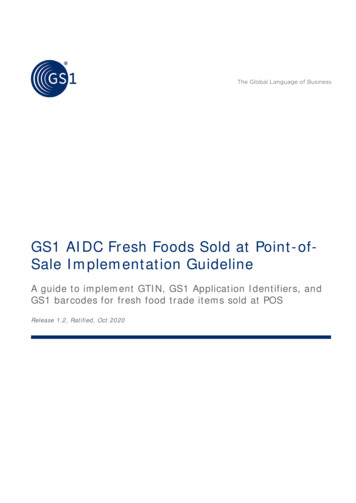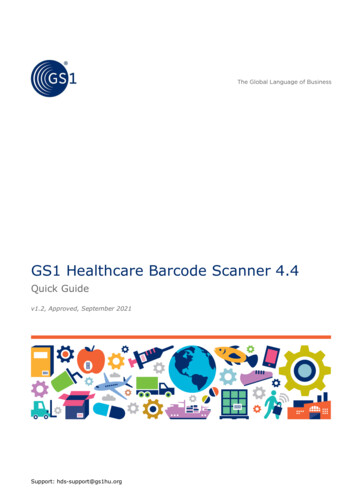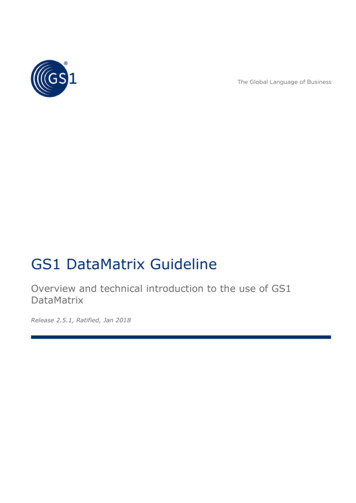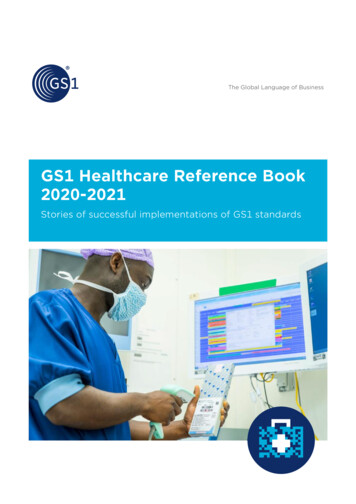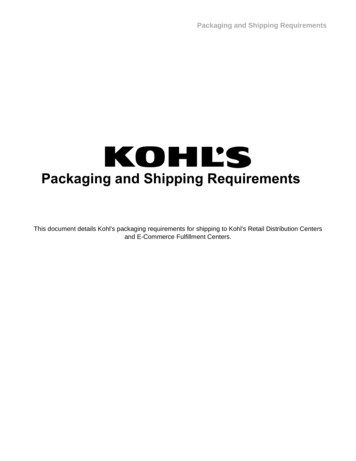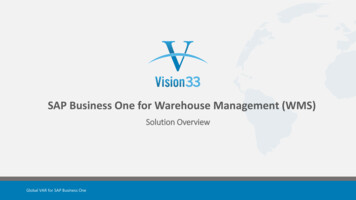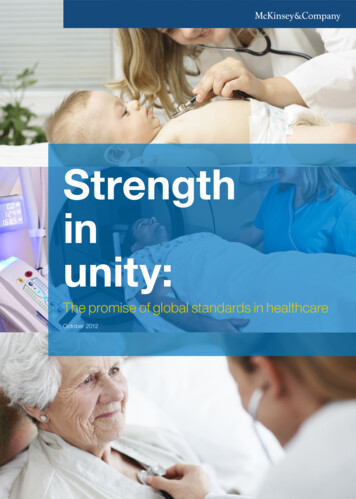
Transcription
CASE STUDYCook MedicalGlobal medical device manufacturer transforms visioninto greater patient safety with GS1 StandardsCHALLENGEWith worldwide manufacturing centers operating as separate entities, Cook Medical(Cook) decided to unify and standardize its business processes to better serve itscustomers and their patients as “one Cook Medical.”“For us, using standards isSOLUTIONprincipally about makingCook Medical chose GS1 Standards, implementing Global Trade Item Numberspatients safer—making sure the(GTINs) and Global Location Numbers (GLNs) to uniquely identify all of itsworldwide products and locations. The company registered its GTINs and attributesright product is delivered atin a GS1 Global Data Synchronization Network (GDSN )-certified Data Pool forthe right time to the patient’ssharing with healthcare systems. The company is integrating these GS1 Standardsbedside.”into its processes for greater visibility while also leveraging them to support the U.S.— DAVE REED, Vice Presidentof Operations and HealthcareFood and Drug Administration’s (FDA) Unique Device Identification (UDI) ruling.BENEFITSBusiness SolutionsPatient safety is of paramount importance to Cook Medical. With GS1 Standardsin place, Cook has improved the traceability of products as they travel throughthe supply chain for a highly effective track and traceability process. Internalbenefits continue to emerge, including an improved customer-centric approachthat enhances the Cook brand, and the promise of increased efficiencies as morehealthcare systems and suppliers adopt standards-based trade.
A Shared Vision“We didn’t need to develop a business case toCook Medical has been at the forefront of minimally invasivemedicine since its founding in 1963 by founder, Bill Cook.make the decision [to adopt standards]. We knewFrom a spare apartment bedroom, Cook launched theit was the right thing to do, so we took action. Forcompany and, in his own words: “For me to make my product,our global company, it only made sense to selectall I needed was a blowtorch, a soldering iron, and a few littleGS1 Standards that are most-used worldwide.”tools and fixtures I could make myself.”— CHUCK FRANZ, Vice President and CIOFrom the beginning, Cook Medical worked closely with itscustomers—physicians and other healthcare professionals—to develop less invasive ways to treat patients.“It’s impossible to talk about innovation at Cook Medicalwithout talking about physicians like Dr. Charles Dotter,”says Gavin Seyler, Cook Medical’s global brand marketingmanager. “Our best ideas have come from listening tophysicians who want less invasive ways to treat patients.This approach to product development was established withDr. Dotter, more than 50 years ago.”The Cook innovation process always starts with listening tocustomers and asking questions to fully understand theirneeds. Solutions are developed together, whether a newproduct, technique, procedure, or even business process.The Right Thing to DoBy the late 90s, Cook Medical’s entrepreneurial culture hadcreated separate, thriving companies that developed andcommercialized life-changing innovations—in very differentways. Worldwide, the company had approximately 376,000SKUs with each company using different interpretations ofCook Medical’s approach for numbering the products.“It wasn’t easy for us to conduct business with our customersaround the globe. Moving products through our globalsupply chain was getting increasingly complex, and trackingproducts in our supply chain was not as efficient as wewanted it to be,” explains Chuck Franz, vice president andOver the years, this model of innovation—listen,CIO. “We quickly came to the conclusion to unify our businessunderstand and collaborate—has led Cook to developas ‘one Cook Medical’ to better serve our customers and themany new products.patients who depend on our products.”Cook was the first company to package the threeAround that same time, many healthcare systems wereprimary components for percutaneous (through the skin)beginning to look for better ways to communicate with Cookcatheterization—needles, wire guides, and catheters—in oneand their other suppliers. The healthcare industry was underconvenient set for cardiovascular procedures. In less than aincreasing pressure to treat a greater number of patients withdecade, its growth trajectory went straight up, allowing theless cost—an ongoing challenge today. And regulatory bodiescompany to expand into Europe and Asia in the 1970s.like the FDA had added regulations as well.The company’s reputation for customization had physicians“For us, using standards is principally about making patientsknocking on Cook’s door to develop other devices to servesafer—making sure the right product is delivered at the rightgastrointestinal endoscopy, urology and women’s healthtime to the patient’s bedside,” says Dave Reed, vice presidentspecialties, leading to the formation of the Cook Medicalof Operations and Healthcare Business Solutions. “While ourresearch and development facility, MED Institute, in the 1980s.customers did not mandate the use of standards, we wereToday, Cook Medical is the world’s largest privately heldstarting to hear from them that a standards-based approachmedical device manufacturer, producing over 16,000was going to become the preferred, or possibly only way ofdevices globally. It has ten divisions based on the 41doing business with them. We also recognized the significantmedical specialties it supports, has manufacturing facilitiesefficiencies a shared system of standards could bring to thein Australia, Denmark and Ireland, in addition to those inindustry. Based on all these reasons, we decided to makethe U.S., and has nearly 2,500 employees in its Indianastandardization a priority for our business.”headquarters alone.“We didn’t need to develop a business case to make thedecision,” says Franz. “We knew it was the right thing to do,so we took action.“For our global company, it only made sense to select GS1Standards that are most-used worldwide.”2
Created globalCreated CookCook productAmericas customerdatabaseservice center (CMI)1999 20012003376,000 SKUsImplementedrepresentingGS1 Standards20,000 partson labels20052012TODAYValidated and alignedWorking towards full UDIpackaging levelcomplianceindicators on labelsPiloting GS1 Standards’ use(GTIN-14 andother AIs)Allows for onePublished attributes toin Cook ManufacturingGDSNSupply Chaincustomer interface todo business with CookTransacting with GTINsCOOK MEDICAL TIMELINE: IMPLEMENTING GS1 STANDARDSA Global LanguageThe analogy Seyler uses is an apt one: “Let’s say that youhave to get gas, you have to go to the grocery store, to thepost office and bank. If you had to speak a different languageat each one of those points, it would probably be a littledifficult to go about your daily routine. With standards, weadopted a global language to help our business be moreefficient and easier to do business with.”The Cook IT team worked closely with the company’squality team and manufacturing entities. “One of the hurdleswe had to tackle was all the different entity ‘standards’ inplace—the different barcodes, lot numbers and ways oflabeling products that had evolved from internal decisionsand requests from government,” says Franz. “This firstimplementation in 2003 was no small task, but had to getdone. We were laying the foundation for traceability andgreater efficiencies in our supply chain.”In 2001, Cook Medical took its initial step to transitionfrom separate product portfolios to a single globalproduct catalog.The company then proceeded to identify each of its productswith a GS1 Global Trade Item Number (GTIN ) encoded in aGS1-128 barcode for labels. Global Location Numbers (GLNs)were assigned to customer “touch points” such as orders anddistribution centers, returns, and Cook Medical Inc.Shared ConvictionImplementing GS1 Standards on labels also provided a majorprerequisite for Cook’s customer service center in NorthAmerica. Launched in 2005, the center is a shared servicesoperation, providing customers with a single point of contactfor questions about any Cook device manufactured anywherethe world.“With GTINs and GLNs assigned, we created a company-“With standards, we adopted a global language tohelp our business be more efficient and easier towide, cross-functional team to help Cook integrate the useof standards into our business transactions and supplychain processes such as recalls,” says Reed. “We starteddo business with.”by focusing on the non-clinical side of our supply chain— GAVIN SEYLER, Global Brand Marketing Managerto make sure Cook products could easily travel from ourmanufacturing centers to customer locations.”3
The Future Today“We had to make the team large enough toWith GS1 Standards, Cook Medical is prepared to complybe effective, yet small enough to be efficient.with the FDA UDI rule requiring manufacturers to labelI believe we were able to strike the right balance.”their products with unique device identifiers. In fact,— SHELLY BOYD, Director of Global IT Shared Service SystemsCook participated in the FDA UDI pilot in 2012 to help thegovernment agency assess the ruling.This meant completing milestones such as ensuring everyproduct barcode was “readable” for scanning at pointsof-delivery and that GTINs were marked on appropriatepackaging levels like cases and pallets.The cross-functional team met regularly to report on activitystatus and work out issues. Shelly Boyd, director of GlobalIT Shared Service Systems, was instrumental in leading thevery detailed, multi-functional process to keep interest andaccountability high.“Each team was a champion of their information,” says Boyd.“We had to make the team large enough to be effective, yetsmall enough to be efficient. I believe we were able to strikethe right balance.”Reed continues, “It took us about five years to complete thisphase for North America-manufactured products only. WhatGS1 STANDARDS PREPARE COOK MEDICALTO COMPLY WITH THE FDA UDI RULING.carried us was a shared conviction in the benefits for ourcustomers and patients.”“Today there is a broader agreement in the industry forThe team’s goal was to be prepared for the healthcarestandardization of product information—something that isindustry’s “2012 GTIN Sunrise.” This industry-led initiativenow being expressed with the UDI,” says Reed. “We believe,defined objectives for healthcare suppliers and providers onas suppliers and providers consume more and more of thethe internal use of GTINs as well as sharing GTIN product datastandardized data, it’s just a matter of time when everyoneand attributes with trading partners via a GS1 GDSN-certifiedwins, especially patients.”Data Pool. Through the Data Pool, the GDSN connects CookThe UDI provides a common language for trading partners toand its subscribing customers to the GS1 Global Registry foruse about products that travel through the supply chain. “Theimmediate electronic sharing of standardized, up-to-date,GTIN and UDI provide the same data and the same benefitsaccurate product information. Currently, Cook’s productof more accurate, efficient supply traceability and patientinformation is shared with 28 customers.safety,” says Franz.Before orders can be placed, Cook products are assignedThe UDI system is comprised of a UDI code, applicationGTINs and only loaded into the GDSN after the GTINof the UDI to device labeling and packaging, and a relatedattributes have been verified.database, the FDA Global Unique Device IdentificationTo date, Cook has loaded 17,179 GTINS into the GDSNDatabase or GUDID.for 13,673 available products. With 16,940 total availableproducts, Cook has published 80 percent of its products inthe GDSN.And nearly 95 percent of the published products’measures are verified, meaning all dimensions and weightshave been validated.“For our business, the move to use globalstandards was a good decision, because thebenefits continue to play out.”— DAVE REED, Vice President of Operations andHealthcare Business Solutions4
“As government gets into the electronic act with nationalproduct catalogs and the GUDID, it’s exciting how muchsimpler our industry can make the transaction of devices,”adds Franz. “Over the next ten to fifteen years, it’s going tobe a very progressive time for healthcare.”COOK MEDICAL RECOGNIZED BYHEALTHCARE TRANSFORMATION GROUPIn a global business like Cook Medical, the move tostandards is a multi-year undertaking and the fullbenefits will only be realized when standardized data“The GTIN and UDI provide the same data and theconsumption reaches critical mass. The evolutionsame benefits of more accurate, efficient supplyhas begun in North America, due to the importancetraceability and patient safety.”of supply chain efficiencies driving down overall— CHUCK FRANZ, Vice President and CIOhealthcare costs, and the greater safety afforded bytraceability, including expeditious product recalls.Shared InsightsIn 2010, five major healthcare systems—GeisingerWith years of experience, the Cook Medical team offersHealth System, Intermountain Healthcare, Kaiseradvice for others considering the move to standards:Permanente, Mayo Clinic and Mercy—formed anStart. “Quite honestly, the first thing is that you just haveaction-oriented collaboration called the Healthcareto make the decision to start. It sounds simple, but it canTransformation Group (HTG) to share best practicesbe hard to do. Accept the fact that you are not going toand drive needed positive change across theconvince everyone that this is the right thing to do, but it is.”healthcare supply chain.Prioritize. “Once the decision to start is made, narrow thescope to prioritize and decide what you need to tacklefirst. Remember that taking small steps is still makingBy communicating in the marketplace through onevoice, the HTG aims to drive the adoption of GS1progress. This approach has given us the ability to be theStandards by suppliers for improved supply chainmost successful.”efficiencies and enhanced patient safety.Decide. “You may have to make decisions that assume certainDuring its 2013 Summit, HTG presented Cook Medicalthings, based on external forces that you cannot control.with its inaugural HTG Excellence Award that honorsMake the best decision and adjust later if necessary. Butkeep going.”a supplier who serves as a leader in the adoption ofGS1 Standards.Commitment. “From a technology process standpoint, thetransition to standards is not really costly. The ‘cost’ comesfrom the significant time, effort and commitment it takesfrom your resources.”Purpose. “Remember why you are doing what you are doing:patient safety is paramount, and the efficient movement ofproducts through the healthcare system benefits everybody.”“For our business, the move to use global standards was agood decision, because the benefits continue to play out,”says Reed.Franz adds, “We’re hearing that standards are makingcustomers’ lives better and this is better for patients. If thereare benefits for both our customers and patients, then it’sultimately better for Cook.”5
About the Companies“We’re hearing that standardsare making customers’ livesCONTACT USGS1 Healthcare US provides expertise, tools and resources to help companiesbetter and this is better forimplement GS1 Standards to improve patient safety and supply chain efficiency. Topatients. If there are benefitslearn more, contact GS1 Healthcare US at GS1HealthcareUS@GS1US.org or visit ourfor both our customers andwebsite at: www.GS1US.org/healthcarepatients, then it’s ultimatelyABOUT COOK MEDICALbetter for Cook.”Since 1963, Cook Medical has worked closely with physicians to develop— CHUCK FRANZ,Vice President and CIOtechnologies that eliminate the need for open surgery. Today we are combiningmedical devices, biologic materials and cellular therapies to help the world’shealthcare systems deliver better outcomes more efficiently. We have alwaysremained family-owned so that we have the freedom to focus on what we careabout: patients, our employees and our communities. www.cookmedical.comABOUT GS1 USGS1 US, a member of GS1, is an information standards organization that bringsindustry communities together to solve supply-chain problems throughthe adoption and implementation of GS1 Standards. GS1 is an AccreditedIssuing Agency for the U.S. Food and Drug Administration for Unique DeviceIdentification (UDI), and GS1 Standards are authorized for use by manufacturersfor UDI implementation.More than 300,000 businesses in 25 industries rely on GS1 US for trading-partnercollaboration and for maximizing the cost effectiveness, speed, visibility, securityand sustainability of their business processes. They achieve these benefits throughsolutions based on GS1 global unique numbering and identification systems,barcodes, Electronic Product Code-based RFID, data synchronization, andelectronic information exchange. GS1 US also manages the United Nations StandardProducts and Services Code (UNSPSC ). www.gs1us.orgABOUT GS1 HEALTHCARE USGS1 Healthcare US is an industry group that focuses on driving the adoption andimplementation of GS1 Standards in the U.S. healthcare industry to improve patientsafety and supply chain efficiency. GS1 Healthcare US brings together membersfrom all segments of the healthcare industry to address the supply chain issues thatmost impact healthcare in the United States. Facilitated by GS1 US, GS1 HealthcareUS is one of over 30 local GS1 Healthcare user groups around the world thatsupports the adoption and implementation of global standards developed by GS1.www.GS1US.org/healthcareFOLLOW US:GS1 US Corporate HeadquartersPrinceton Pike Corporate Center1009 Lenox Drive, Suite 202, Lawrenceville, NJ 08648 USAT 1 937.435.3870 E info@gs1us.org W www.gs1us.org 2014 GS1 US ALL RIGHTS RESERVED
specialties, leading to the formation of the Cook Medical research and development facility, MED Institute, in the 1980s. Today, Cook Medical is the world's largest privately held medical device manufacturer, producing over 16,000 devices globally. It has ten divisions based on the 41 medical specialties it supports, has manufacturing facilities

